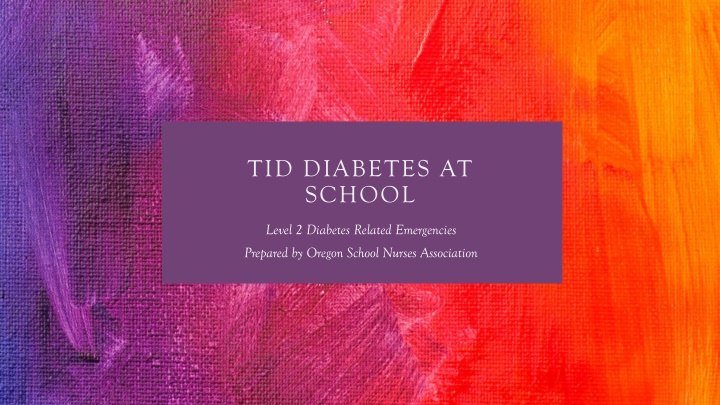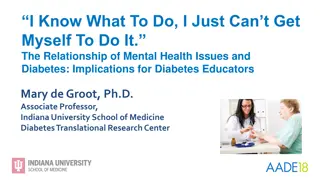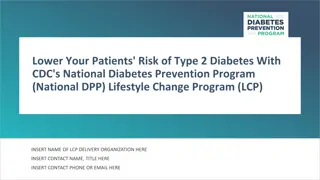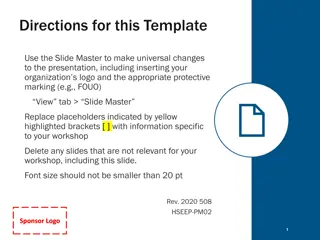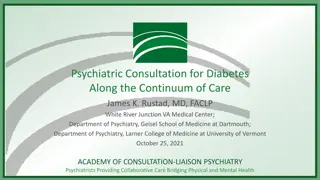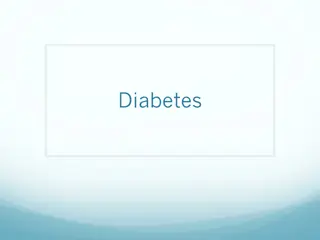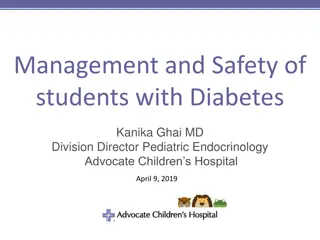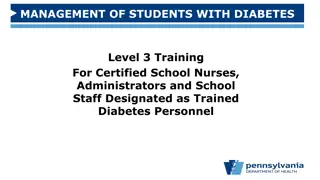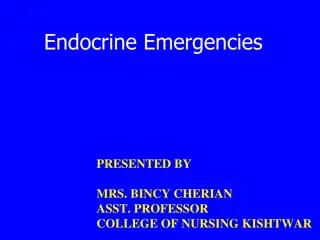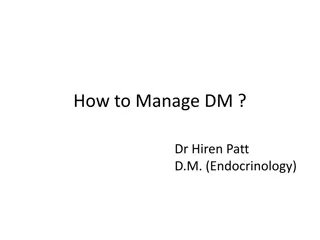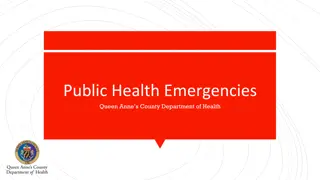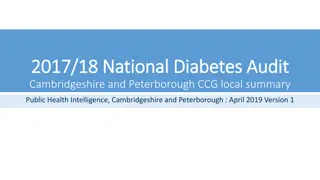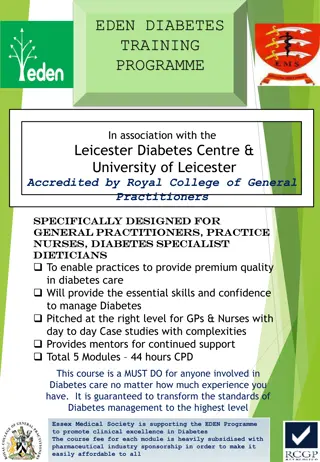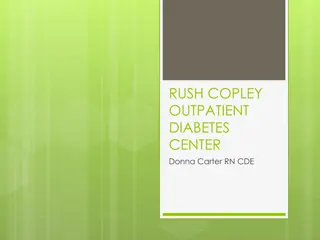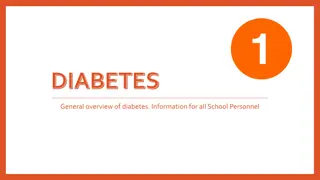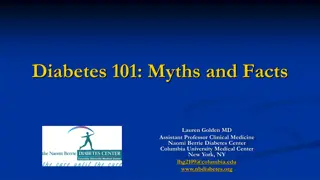Diabetes Emergencies at School Preparedness
Oregon School Nurses Association provides educational materials on handling diabetic emergencies at school, focusing on safety mechanisms and glucagon administration for severe hypoglycemia. The content covers understanding and preventing diabetic emergencies, steps for response, medication identification, and the role of Unlicensed Assistive Personnel (UAPs) under nurse supervision. It discusses hyperglycemia, hypoglycemia, and diabetic ketoacidosis as potential emergencies, emphasizing the significance of proper training and care protocols in school settings.
Download Presentation

Please find below an Image/Link to download the presentation.
The content on the website is provided AS IS for your information and personal use only. It may not be sold, licensed, or shared on other websites without obtaining consent from the author.If you encounter any issues during the download, it is possible that the publisher has removed the file from their server.
You are allowed to download the files provided on this website for personal or commercial use, subject to the condition that they are used lawfully. All files are the property of their respective owners.
The content on the website is provided AS IS for your information and personal use only. It may not be sold, licensed, or shared on other websites without obtaining consent from the author.
E N D
Presentation Transcript
TID DIABETES AT SCHOOL Level 2 Diabetes Related Emergencies Prepared by Oregon School Nurses Association
DISCLAIMER Oregon School Nurses Association's educational material and/or language are intended as examples that may serve as a tool for those responsible for drafting and carrying out educational content that meet the needs of a local school or district. These examples are not authoritarian, nor should they be viewed as complying with any requirements specific or unique to any school or district or state laws. Educational resources and language should not substitute or replace the advice of legal counsel and/or research on applicable federal or local laws, regulations or ordinances.
To ensure safety mechanisms for response to diabetic emergencies in the school setting PURPOSE To ensure appropriate information is provided to emergency staff to carry out administration of glucagon for severe hypoglycemia.
Describe Describe a diabetic emergency at school Understand Understand prevention of diabetic emergencies LEVEL TWO OBJECTIVES Explain Explain steps to response of diabetic emergencies Identify Identify medications for diabetic emergencies
ACKNOWLEDGEMENTS Unlicensed Assistive Personnel (UAPs) can only be designated emergency tasks under the oversight of a registered nurse with training that is compatible with Oregon Laws related to emergency medications and nurse practice. UAPs should have validated knowledge and competency prior to being assigned the emergency response of a student with T1D The nurse reserves the right under their license to determine a UAP is not qualified or capable of direct care. Glucagon training has specific OARs and ORSs that must be adhered to. Medication administration training is a prerequisite to glucagon training Students IHPs are the first line of direction for student specific care Staff providing emergency care should be CPR trained
DIABETES RELATED EMERGENCIES HYPERGLYCEMIA HYPOGLYCEMIA DIABETIC KETOACIDOSIS Serious complication Occurs with sustained high blood glucose levels over time. Cells do not get enough glucose, because of lack of insulin. Body breaks down fat, which created a chemical called ketones. High levels of ketones can poison the body. SEVERE HYPOGLYCEMIA Blood glucose levels that are so low they impact functioning and level of consciousness. May occur rapidly. Occurs from too much insulin, not enough food, more than typical exercise. Potentially fatal if not treated immediately
REVIEW OF HYPERGLYCEMIA High Blood Glucose
CONTRIBUTORS TO HYPERGLYCEMIA Not taking enough insulin Eating extra food without taking extra insulin Getting less activity than normal Stress Illness Excitement
EARLY SIGNS OF HYPERGLYCEMIA Frequent urination Increased thirst Blurred vision Headache Mood changes Fatigue Warm skin Stomachache
Fruity smelling breath Nausea and Vomiting Dry Mouth Weakness SUSTAINED HYPERGLYCEMIA Confusion Coma Abdominal Pain Rapid shallow breathing Ketones DKA
Short term: Sustained hyperglycemia can lead to a complications called diabetic ketoacidosis (DKA) COMPLICATIONS OF SUSTAINED HYPERGLYCEMIA Long term: Chronic high blood glucose leads to vascular and neuropathic complications, and increases the risk of cardiovascular disease, peripheral neuropathy, kidney failure and impaired vision among other compciations.
DIABETIC KETOACIDOSIS Hyperglycemia Occurs with high levels of blood acids called ketones The body begins to burn fat when there is not enough glucose in the cells for elegy. Produces byproduct called ketones. DKA Tested through high blood glucose and urine ketones Can cause coma and death when not addressed.
Dry mouth Dry Skin Feeling extremely thirsty Frequent urination Fatigue/weakness Confusion Flushing Sweet smelling breath Shortness of breath Abdominal pain Muscle Pain Headache Nausea and Vomiting SYMPTOMS OF DKA
Illness Missing insulin doses Malfunctioning pump RISK FACTORS FOR DKA Physical injury Alcohol or drug use Certain medications
TREATING DKA Observe student Follow IHP Limit activity Call your nurse! Dismiss to parent/guardian Refer to medical care Fluid Insulin Correction replacement
PREVENTING DKA Follow Follow insulin regimen and use correction doses, when needed Stay in Stay in target range as much as possible Check Check blood glucose often, especially when ill, injured or experiencing high stress Replace Replace fluids and electrolytes when ill or exercising Talk Talk to doctor about frequent highs Take Take other medications as prescribed
TREATING HYPERGLYCEMIA Not all episodes of hyperglycemia will lead to DKA Hyperglycemia is not always identifiable without monitoring blood glucose Designated UAPs should provide care to students experiencing hyperglycemia Care should be under the provision of the IHP and may include: Extra insulin Increased hydration Restrictions in activity Increased bathroom access.
REVIEW OF HYPOGLYCEMIA Low Blood Glucose
All individuals with diabetes experience low blood sugar from time to time This means that blood sugar has dropped below the target range LOW BLOOD SUGAR (HYPOGLYCEMIA) Causes include too much activity or too much insulin or missed meal Unlike hyperglycemia, hypoglycemia can come on suddenly and progress rapidly
Shakiness Dizziness Sweating Hunger Rapid heart rate EARLY Difficulty concentrating SYMPTOMS OF HYPOGLYCEMIA Confusion Irritability Anxiety Headache Weakness Pallor
Clumsiness Inability to eat or drink Muscle weakness MODERATE TO SEVERE HYPOGLYCEMIA Difficulty speaking Blurry vision Drowsiness Confusion
Seizure Change in level of consciousness SEVERE HYPOGLYCEMIA Death
RISK FACTORS FOR HYPOGLYCEMIA Higher insulin requirements Insulin pen or injectable insulin regimen Poor glycemic control History of frequent hypoglycemia Multiple insulin regimens
CAUSES OF HYPOGLYCEMIA Too much insulin More exercise than typical Not enough food intake
TREATING MILD TO MODERATE HYPOGLYCEMIA Provide Provide fast acting sugar Do not move Do not move student ( walking can further decrease blood glucose) Check and Monitor Check and Monitor blood glucose ( designated UAPs)
Glucose Tablets Candy ( not sugar free or chocolate) Soda ( not diet) FAST ACTING SUGAR Juice Sugar Honey
Severe Act hypoglycemia is an emergency Immediately Place student in recovery position Stay with student TREATING SEVERE HYPOGLYCEMIA Call glucagon trained staff or nurse Call 911
GLUCAGON Hormone that helps liver release glucose Raises blood glucose levels Occurs naturally in the body Administered when someone with T1D is unable to swallow liquid or food because of severe hypoglycemia Administered by injection or nasal spray
Oregon law (ORS 433.800-830) authorizes lay persons to be trained to administer glucagon injections to persons experiencing severe hypoglycemia (low blood sugar). The Public Health Division is responsible for developing training protocols for the training of emergency providers and their periodic retraining. The OHA-Public Health Division adopted Administrative Rules (333-055- 000 - 333-055-0035) to support training emergency glucagon providers. The Public Health Division is responsible for developing training protocols for the initial training of these emergency providers and their periodic retraining. OREGON LAWS ORS 433.800-433.830 Allows for the administration of epinephrine for anyone experiencing a severe allergic reaction Allows for the administration of Glucagon for an individual with a prescription for Glucagon suffering from severe hypoglycemia Allows for the administration of an injectable medication to treat adrenal insufficiency when a student is experiencing an adrenal crisis
GLUCAGON ADMINISTRATION Injectable Intranasal Injected into subcutaneous tissue such as arm, stomach or leg Must mix at the time of injection and administer dose per MD order. Kit contains a vial with unmixed glucagon and syringe of clear liquid diluant. Administered into the nostrils No injection ( no needles) Premixed/dosed Kit contains nasal spray
INJECTABLE GLUCAGON Refer to Oregon Training Protocol for Emergency Glucagon Provider Formulations may be in glucagon kits or autoinjectors.
Shrink wrap on nasal glucagon should not be removed until ready to use. Remove shrink wrap by pulling on red stripe. Do not touch plunger until ready to administer Hold the device between fingers and thumb ADMINSITERING INTRANASAL GLUCAGON Insert tip into one nostril until finger touches the outside of the nose Push plunger finely all the way in Dose is complete when green line disappears
Call 911 if not previously called Roll the person onto their side, as they may vomit after glucagon administration. AFTER GLUCAGON Monitor individual until alert or until EMS arrives. Once a person is alert and able to swallow provide a fast-acting glucose liquid ( soda, juice) Check blood glucose level
DISCLAIMER This is sample material for training for diabetic emergencies A student's provider dictates students treatment regimen including emergency mediations State laws govern the scope of practice and emergency training for unlicensed assistive personnel at school Each nurse is responsible to identify their own state requirements State laws are specific on glucagon administration in the school setting Identify the processes that must occur in the school setting Identify whether or not unlicensed staff can administer glucagon Identify specific training that may be required for glucagon providers in the school setting You must follow state laws that govern scope of practice and training
REFERENCES IMAGES USED WITH WRITTEN PERMISSION FOR NASN FROM ADAM BMJ Best Practice (2020) Diabetic ketoacidosis. Retrieved from https://bestpractice.bmj.com/topics/en-gb/3000097 Canadian Pediatric Society. (2021) Diabetes at School Retrieved from https://www.diabetesatschool.ca/tools/video-series Mayo Clinic (2021) Type 1diabetes. Retrieved from https://www.mayoclinic.org/diseases-conditions/type-1- diabetes/symptoms-causes/syc-20353011 Mayo Clinic (2021) Type 2 diabetes. Retrieved from https://www.mayoclinic.org/diseases-conditions/type-2- diabetes/symptoms-causes/syc-20351193 Deeb, L. C., Dulude, H., Guzman, C. B., Zhang, S., Reiner, B. J., Pich , C. A., Pradhan, S., & Zhang, X. M. (2018). A phase 3 multicenter, open label, prospective study designed to evaluate the effectiveness and ease of use of nasal glucagon in the treatment of moderate and severe hypoglycemia in children and adolescents with type 1 diabetes in the home or school setting. Pediatric Diabetes, 19(5), 1007 1013. https://doi.org/10.1111/pedi.12668 Johansen, A., Kanijo, B., Fredheim, S., Olsen, B., Hertz, B., Lauridsen, M. H., Andersen, M. L. M., Mortensen, H. B., & Svensson, J. (2015). Prevalence and predictors of severe hypoglycemia in Danish children and adolescents with diabetes. Pediatric Diabetes, 16(5), 354 360. https://doi.org/10.1111/pedi.12171
REFERENCES Canadian Pediatric Society. (2021) Diabetes at School Retrieved from https://www.diabetesatschool.ca/tools/video-series Deeb, A., Yousef, H., Al Qahtani, N., Artan, I., Suliman, S., Tomy, M., Abdulrahman, L., Al Suwaidi, H., Attia, S., & Nagelkerke, N. (2019). Novel ambulatory glucose-sensing technology improves hypoglycemia detection and patient monitoring adherence in children and adolescents with type 1 diabetes. Journal of Diabetes & Metabolic Disorders, 18(1), 1 6. https://doi.org/10.1007/s40200-018-0351-9 Karges, B., Schwandt, A., Heidtmann, B., Kordonouri, O., Binder, E., Schierloh, U., Boettcher, C., Kapellen, T., Rosenbauer, J., & Holl, R. W. (2017). Association of insulin pump therapy vs insulin injection therapy with severe hypoglycemia, ketoacidosis, and glycemic control among children, adolescents, and young adults with type 1 diabetes. JAMA, 318(14), 1 358-1366. https://doi.org/10.1001/jama.2017.13994 Lilly USA. (2021) BASQIMI Instructions for use. http://pi.lilly.com/us/baqsimi-us-ifu.pdf Lilly USA (2021) Injectable Glucagon. https://www.lillyglucagon.com/ Tournilhac, C., Dolladille, C., Armouche, S., Vial, S., & Brouard, J. (2020). Evaluation of a new training program to reassure primary school teachers about glucagon injection in children with type 1 diabetes during the 2017 2018 school year. Archives de P diatrie, 27(4), 212 218. https://doi.org/10.1016/j.arcped.2020.02.002
